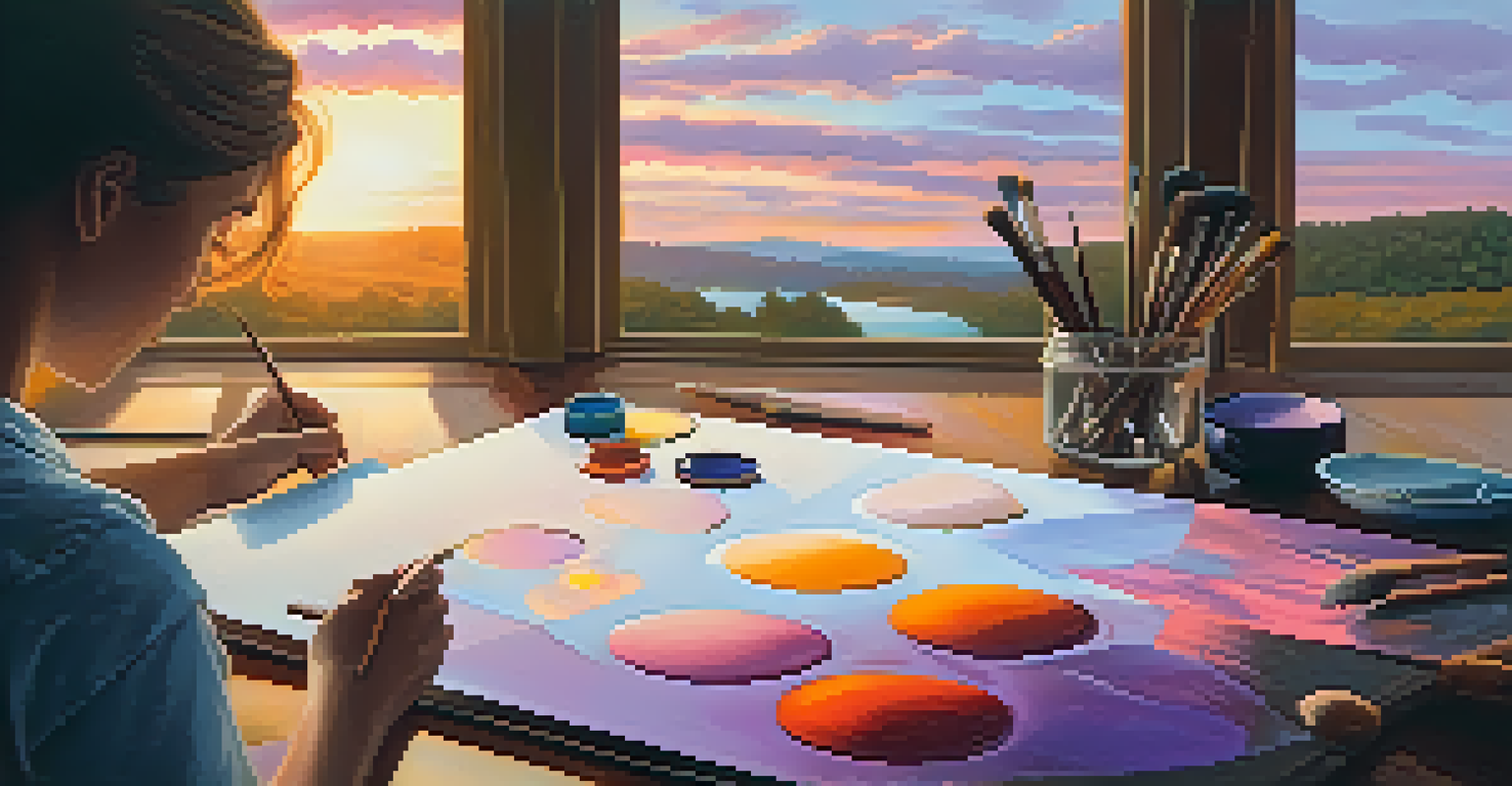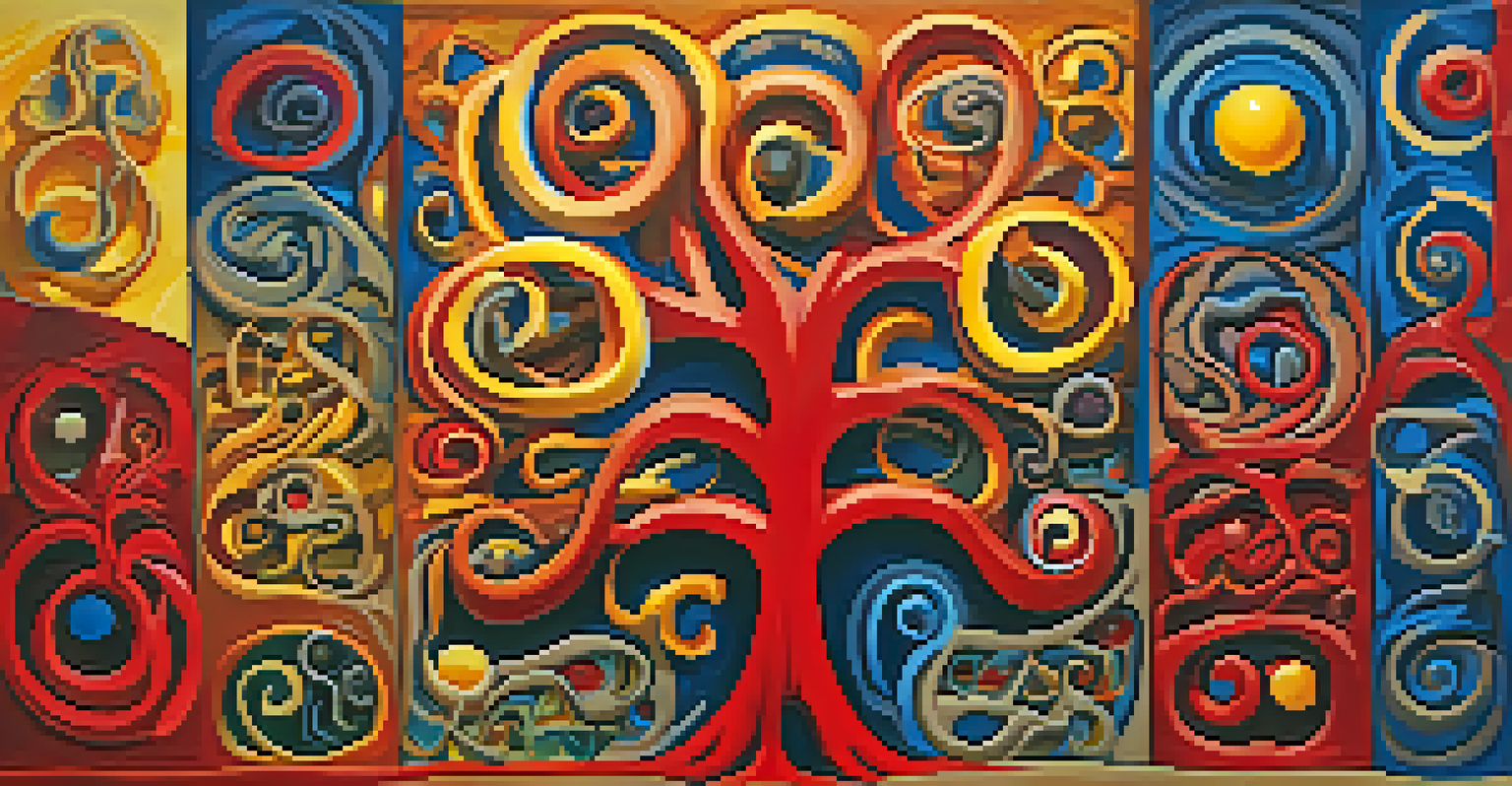Art and Memory: How Time Shapes Our Perception of Art

Understanding the Connection Between Art and Memory
Art and memory share a profound connection, as our experiences shape how we perceive artworks. When we encounter art, it often triggers memories, allowing us to relive moments from our past. This interplay creates a unique bond between the viewer and the artwork, as personal narratives intertwine with artistic expression.
Art is the most beautiful of all lies; it is a verification of the memories we create and the stories we tell.
For instance, looking at a painting may remind us of a family vacation or a beloved friend. These associations enhance our appreciation of the piece, turning a simple viewing into a deeply personal experience. Therefore, understanding this connection can help us appreciate art on a more intimate level.
Ultimately, each person brings their own set of memories to an artwork, making the experience uniquely subjective. This highlights the notion that art is not just about aesthetics; it's about the stories we carry and how they resonate with what we see.
The Role of Time in Shaping Artistic Perception
Time plays a crucial role in how we perceive art, influencing both the creation and reception of artworks. As time passes, our understanding of a piece can change, reflecting shifts in culture, society, and personal circumstances. This evolution often leads to new interpretations that may not have been evident at the time of its creation.

For example, a painting that once symbolized a specific political movement might later be viewed through a more personal lens as societal values change. This fluidity highlights the dynamic nature of art and the importance of considering the context in which it was created. Time acts as both a filter and a lens, altering our perceptions.
Art Triggers Personal Memories
The connection between art and memory allows viewers to relive personal experiences, enhancing their appreciation of the artwork.
Moreover, our own passage through time affects how we engage with art. A piece of art that once resonated with us in youth may take on new meaning as we grow older, showcasing how our life experiences color our interpretations.
Art as a Record of Personal and Collective Memory
Artwork often serves as a repository of memories, both personal and collective. Artists frequently draw upon their own experiences, embedding their emotions and memories into their creations. This personal touch can resonate with viewers, evoking shared feelings and memories.
The painter's only solid ground is memory. A painting is not a representation of reality, but a representation of what the artist remembers.
On a broader scale, art can capture significant historical moments, becoming a visual record of cultural memory. Think of iconic photographs from pivotal events; they transcend time, allowing future generations to connect with the past. In this way, art acts as a bridge, linking us to our shared history.
Thus, whether through individual expression or collective narrative, art holds the power to preserve memories. It invites reflection and conversation, making it a vital part of our cultural landscape.
How Memory Influences Artistic Creation
Memory significantly influences the creative process, shaping how artists express their thoughts and feelings. Many artists draw inspiration from their past experiences, translating memories into visual forms. This can manifest in various ways, from the choice of colors to the themes explored within the artwork.
For instance, an artist might depict a childhood memory in a vivid landscape, using colors that evoke the emotions felt during that time. This personal narrative becomes a part of the artwork, inviting viewers to interpret it through their own experiences. In essence, memory acts as both muse and guide.
Time Alters Art Perception
As time progresses, both the context of the artwork and our personal experiences evolve, leading to new interpretations of the same piece.
Furthermore, the act of creating art can itself be a form of memory-making. As artists engage with their materials, they often find themselves reflecting on their past, allowing the creative process to serve as a therapeutic outlet for emotions and experiences.
Cultural Context and Memory in Artistic Interpretation
Cultural context plays a vital role in how we interpret art, shaping our understanding of its significance. Different cultures have unique histories and memories that inform their artistic traditions. This context can create layers of meaning that might be overlooked by those outside that culture.
For example, indigenous art often incorporates symbols and stories that reflect the community's history and values. Understanding these elements requires an appreciation for the cultural memory embedded within the artwork. Without this knowledge, the art may be misinterpreted or its significance diminished.
Thus, recognizing the cultural backdrop of a piece can deepen our appreciation and enhance our connection to it. Art becomes a conversation, bridging gaps between cultures and inviting us to explore diverse narratives.
The Impact of Technology on Art and Memory
Technology has transformed the way we create, share, and remember art, reshaping our interactions with it. Digital art forms, for example, allow for new forms of expression and can evoke memories in ways traditional mediums may not. This evolution invites a fresh exploration of memory through the lens of modern technology.
Moreover, the internet has made art more accessible, allowing people to discover and engage with pieces from around the world. This democratization of art means that collective memories can be shared and celebrated across borders, creating a global dialogue. However, it also raises questions about authenticity and the preservation of original contexts.
Art Preserves Collective Histories
Artwork serves as a visual record of cultural and personal memories, fostering reflection and conversation about shared histories.
As we navigate this digital landscape, our relationship with art and memory continues to evolve. We must consider how technology can enhance our understanding while remaining mindful of the traditions and stories that shape artistic expression.
The Future of Art in Relation to Memory
Looking ahead, the relationship between art and memory will likely continue to evolve. As new artistic mediums emerge and societal values shift, our interpretations of art will adapt accordingly. This ongoing dialogue between past, present, and future keeps art relevant and meaningful.
Furthermore, as we become more aware of the importance of memory in shaping our identities, artists may increasingly explore themes of nostalgia and remembrance in their work. This could lead to a resurgence of interest in personal and collective narratives, encouraging deeper connections with audiences.

Ultimately, the future of art will remain intertwined with memory, serving as a canvas for reflection and expression. By honoring the past while embracing innovation, artists will continue to captivate and inspire us, reminding us of the beauty inherent in our shared human experience.